Brussels logo by Johan DeMoor.The sixteenth edition of the Brussels Cartoon and Animated Film Festival, organized by Folioscope, was held from February 4-16, during the Mardi Gras school holiday.
Apart from a retrospective held at the Museum of Cinema, this year's event was limited to one movie theater (Passage 44). The organizers, essentially, had not been able to reach a satisfactory agreement with the Botanique (a publicly-subsidized cultural center) that had served as the venue for specialized programs for previous editions.
Festivalgoers nevertheless didn't suffer because of this,...
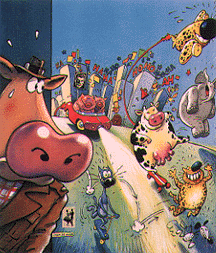
The sixteenth edition of the Brussels Cartoon and Animated Film Festival, organized by Folioscope, was held from February 4-16, during the Mardi Gras school holiday.
Apart from a retrospective held at the Museum of Cinema, this year's event was limited to one movie theater (Passage 44). The organizers, essentially, had not been able to reach a satisfactory agreement with the Botanique (a publicly-subsidized cultural center) that had served as the venue for specialized programs for previous editions.
Festivalgoers nevertheless didn't suffer because of this, because the team of Philippe Moins and Doris Cleven managed the schedule so as to maintain the event's reputation for strength and diversity. The public acknowledged this by filling the house for both evening and afternoon screenings (these were especially oriented toward young people, who always enjoy the festive ambiance, thanks to the presence of theater troupes, brass bands, clowns and live broadcasts for children by Belgium television).
The programming for young people and for an informed public, shorts and features, auteur films, making of films, and series all found their place next to talks given by representatives of several animation studios (Disney, Clayart, Acme, Hibbert Ralph, Ex-Machina), producers of children's videos (Ubisoft), and special effects (Industrial Light and Magic, Softimage, Medialab, McGuffligne) . . . .
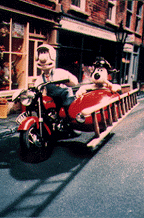
Feature Films
Unlike other international festivals that have strict definitions of what animation is, Brussels uses a much broader definition, which otherwise might seem secondary; for example, it includes live-action films where computer animation clearly plays a part in the creation of special effects. This explains the presence among the Belgian premieres of Jonathan Frakes' Star Trek: First Contact, whose visual conception seems more successful than it's somewhat scattered script.
Also on the menu was Institute Benjamita, a live-action feature which allowed us to get a deeper knowledge of Stephen and Timothy Quay's universe, for which the festival had paid attention to in the past. These British brothers have made a difficult work, strange but fascinating, much like David Lynch's early films, on human relationships, hierarchies and Kafkaesque mysteries of a boarding school for the less bizarre.
Overall, one of the outstanding aspects of the 1997 edition was the significant proportion of features which, "as a rule," are of the type more suitable to the theater's size. But to judge by the titles (previews and revivals), which are being distributed in Belgian, the market remains determined by the stubborn prejudice that tends to reduce animation to a diversion for kids.
For instance, Pinocchio, tender psychological version of Collodi's novel, directed by Steve Barron, benefited from a remarkable integration of the puppet into a world of real actors. On the other hand, the animation of some of the secondary figurines seemed more rudimentary.
I don't need to introduce Space Jam, which catapulted--literally--NBA star Michael Jordan into Warner Bros.' toon world. Then again, it's an undeniable technical accomplishment which helps a script of no particular signficance.
Among the productions benefitting from this type of exposure, one can citeLa freccia azzura (The Blue Arrow) by the Italian Énzo d'Alò, an attractive tale for children done with a lucid graphic style, but which suffers from being a bit long.
Contrary to those noted above, many other features haven't found a Belgian distributor. Thus, their presentation here presented a rare chance for the Brussels public to (re)discover them. This was the case with Isao Takahata's poignant Tomb of the Fireflies, whose imagery and subject--children and war--distinguish it from run of the mill anime.
Among the feature films specifically aimed at adults, there wasWerner II, which presentsnew chapter in the comic book hero's adventures, which is very popular in Germany, and Drawn From Memory, an unique autobiographical experience by the Czech-American Paul Fierlinger: The filmmaker recounts his childhood, his youth, his escape from Europe at the start of World War II, his return to Prague where his father became a Communist Party dignitary, and his attempts to fight the regime. Animation may not seem appropriate for such a topic, but as the title suggests, the filmmaker, in a style that wavers between impressionism and gentle caricature, profits from the graphic possibilities to show things as he remembers them and not with objectivety.
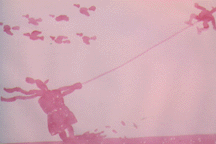
Shorts
Ron Diamond, producer of Drawn From Memory, also at the festival representing Acme Filmworks, a studio which was honored with a retrospective. It was the occasion to show how just a commercial and advertising campaign on preventative medicine could exhibit the characteristic style of a filmmakerr who was given creative freedom. And for a good reason: Acme has called on the talents of the caliber of Bill Plympton, Paul Driessen, Richard Goleszowski, Gary Bardin, and even Raimund Krumme, who was the subject of a separate tribute.
This German filmmaker, whose drawings seem to inspire the scenario and not vice versa. The actions and predicaments of his characters are, in effect, conditioned by the graphic characteristics, geometries, perspectives and optical illusions in his barren and distant world.
As one can see, short films were also shown in restrospectives, as there were six programs dedicated to films of new directors. For instance, festivalgoers could discover The Grey-Bearded Lion directed by Andrei Khrajnovski, from a script by Tonino Guerra, celebrated collaborator of Francesco Rosi, Antonioni, Fellini, the Taviani brothers, Théo Angelopoulos and Andrei Tarkovski, among others. The formality of this metaphysical allegory on the human condition gives it a grave and austere tone, but its aesthetic splendor along with several well-crafted techniques do not leave one indifferent.
Other films worth noting include: The Tale of the Cat and the Moon, affectionate black and white poem by Portugal's Pedro Serrazina, the deliciously impertinent DNA by Giorgio Valentini, Trainspotter featuring the black comedy of Jeff Newitt and Neville Astley, and, once again, the last Cartoon d'Or winner, Tyron Montgomery's Quest, with its arid world consisting of sand, stones, metal and water.
Graham Ralph's children's fable, The Forgotten Toys, is at once funny and touching, also profited from the work of Bob Hoskins, who lends his voice and temperament to one of the heroes. This Christmas road movie, made for British television, was presented in a 25 minute format particularly well suited to young viewers.
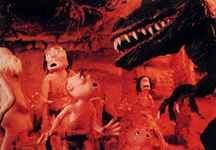
Series
The dynamism of English broadcasters was as incredible as ever. Among the series honored at the festival, two were from programs destined for Britain's small screens. Gogs, by Deinol Morris and Michael Mort, which uses puppet and plasticine animation, is a prehistoric comedy in the slapstick spirit of naughty students and has an unbridled scatological tone, though perhaps too schematic to be fully effective.
One finds the same "taste" in Crapston Villas (another work in 3-D) by Sarah Ann Kennedy, a devastating soap opera parody, which offers a "hideous, dirty and nasty" vision of British society, which isn't reticent about neurotics, delinquents, depressives, vulgarians, or senile people. Even the small house cat is known to be depraved and suffering from an incurable digestive problem; the miniature sets, remarkably, do not omit any sordid details: traces of rust on the sinks, wallpaper peeling off because of humidity, endemic disorder, etc. The variety of characters and situations gives the show a certain political incorrectness, a comic strength and a provocative new life to each episode.
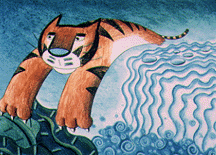
Computer Animation
For scheduling reasons, the `97 festival could not present, as it did before, a program from Imagina 97. But even so, the sessions dedicated to computer animation maintained their popularity. Their success testifies to the curiosity computer graphics continues to elicit. With several exceptions (including Toy Story, which was revived at the festival, Jerzy Kular's Krakken, the Insektors series . . .), we must admit that computer animation remains a subject in itself, and is thus not used enough as a full means of expression in the service of specific personal creations.
This opinion doesn't deny the convincing results created by these virtual images. But we can still ask oneself the following question: Beyond comedy, can the texture of computer images engender an emotional range equivalent to those produced by traditional means and allow it to have equal effectiveness in as many genres?
Nevertheless, the large selection shown at the Brussels Animation Festival did not elicit a definitive answer to this question.
--Translated from the French by Harvey Deneroff
P.S.: Although the Brussels Festival is a noncompetitive, it did award an audience prize, voted on by "special pass" holders based on viewing the short films in the international selection.The winner was Noël gourmand, a Belgian student film made at La Cambre by Corinne Kuyl. For the record, films that placed second through eighth were: Quest (Germany, Thomas Stellmach & Tyron Montgomery), Pas de Kadeaux pour Noël (France,Georges Lacroix), Estoria do Gato e da lua (The Tale of the Cat and the Moon) (Portugal, Pedro Serrazina), There is More Than One Way to Kill a Cat (United Kingdom,David Westland), Barflies by Greg Holfeld (Australia), Capriccio (Hollan, Ellen Meske), Bride of Resistor (USA, Mark Gustafson), and Bernol's Family (Belgium, Luc Otter).
To purchase Best of the Brussels Animation Festival videos, visit the AWN Store.
André Joassin is a Brussels-based journalist for Le Soir and Canal +.







